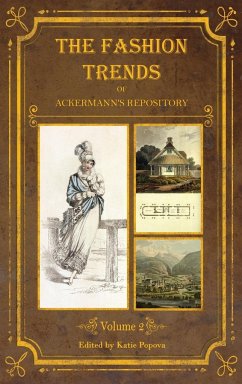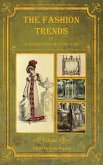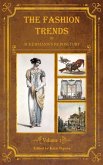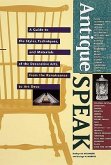In this second volume of "The fashion trends of Ackermann's Repository" we look into the next 5 years of the life of the periodical, from 1814 until the end of 1818. At this time of his life Rudolph Ackermann is an established print seller, book-seller, publisher and businessman, among other successful ventures. His Repository of Arts shop has grown and now consists of gallery, tea room, circulating library, and he hosts a regular evening talk for invited guests. The periodical is successful and well established, boosting thousands of subscribers. By this time he has created a recognizable brand, especially with his coloured plates, and without subscribing to any political views himself, R. Ackermann continues to deliver cutting edge information on current movements in politics and culture. In its pages The Repository continues to exhibit artwork by those who were not admitted into the Royal Academy, such as engravers, draftsmen and colorists. Ackermann successfully establishes business based on hand coloured aquatint plates, and in 1818 this has made him one of the first British publishers to operate and own lithography press, which explains the appearance of more lithography plates on the pages of the magazine during this period. This instalment of the series starts with the 11th volume of the publication and ends with volume 6 of the second series. After volume 14 the original series ends, and the second series begin in December of 1815 with volume 1 anew. What necessitated the change was Ackermann's eventual realization that the primary audience of The Repository should be women, and shifted the tone and content of articles toward women, including fashion and cultural events as the primary topics. His shift, along with that of other publishers, encouraged " female consumption by characterizing it as a patriotic and virtuous exhibition of taste in the home". ( Bermingham; Katherine D. Harris). As of January 1816 the periodical continues with revamped content as Volume 1, Second Series. With this shift, we see the departure of the hunting and military portrait plates, of the first 5 years of the periodical, and the arrival of scenic and romantic travel plates, more consistent continuation of the needlework patterns and the new pictorial cards. The fashion plates offer more variety in dress styles, including the first ones specifically designed for brides. Sadly, for the next 5 years (1814 - 1818) there were no more children or men's fashion styles offered. There is a marked increase in the mourning dresses for every occasion, triggered by the death in childbirth, of the popular Princess Charlotte of Wales. By the end of 1818 The Repository of Art is the most fashionable place for the upper classes of London to visit. The magazine is eagerly anticipated by society women and has huge influence on the fashion of the day. Regardless of its shifted focus towards subjects more appreciated by the ladies of the time Ackermann continues to depict 19th century England with vibrant detail.
Hinweis: Dieser Artikel kann nur an eine deutsche Lieferadresse ausgeliefert werden.
Hinweis: Dieser Artikel kann nur an eine deutsche Lieferadresse ausgeliefert werden.








